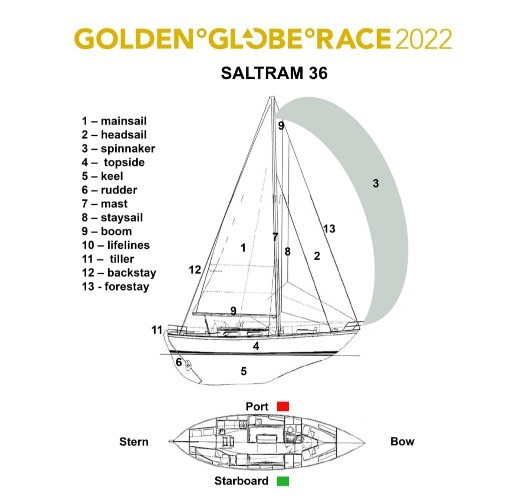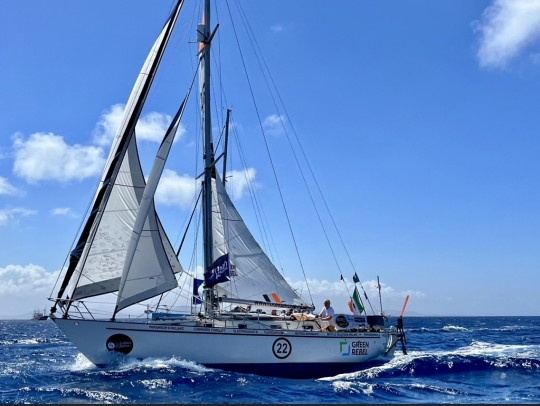Boat Name: — Green Rebel
Type: — Saltram Saga 36
Designer: — Alan Pape
Builder: — K.R. Skentelbery & Sons
LOA: — 10.90m
LWL: — 8.61m
Beam: — 3.28m
Draft: — 1.8m
Displacement: — 9500kg
Sail area: — Main: 30.5; Jib: 19.4; Foresail: 9.7; Total = 59sq m.

Pat has selected the Saltram Saga 36 for his boat, similar to ‘Suhaili‘ but four feet longer.
Alan Pape designed her as a development, from the Colin Archer “Redningskoite” Sailing lifeboat hull.
For many years they have been regarded as being amongst the most seaworthy around, but are substantially faster than the original. She will come into her own in the Southern Ocean, able to hold on to working sail in strong winds, without heeling more than 20°, while in soft weather, she can sail so well because of her wet area. It is good that his boat has a quarter-berth, galley and heads aft, useful in bad weather as a wet area.

Preparations for the GGR26
Nine months at sea alone in a small boat, it is the longest, loneliest sporting event in the
World. It will entail stepping back to the Golden Age of solo sailing. Entrants are limited to
sailing similar yachts and equipment to that which was available to Sir Robin Knox Johston
in the 1968 race. That means sailing without modern technology or the benefit of satellite-
based navigation aids.
Between the original dream and unfinished business, my second campaign in the GGR will
be stronger than ever. The Aries self-steering will be used again and a second Aires unit on
board as a spare. After GGR22 there are some modifications to be made on the Saltram
Saga 36. A slight change to the rigging, remove the fire, new sails, this time make sure the
weather fax is working properly, etc.
The boat I chose is a Saltram Saga 36 and I was happy with its performance in the GGR22,
having remained in touch with the leaders right up to Cape Town. Even though it’s heavy
displacement may make it slower than some of the other boats, its inherent strength will give
it an advantage in the storms, particularly in the Southern Ocean. The experience I have
gained from competing in the GGR22 will be a significant advantage.
I have learned to my cost that the key challenge of this race is not the lack of technology,
but the long time alone out in the deep without being able to get parts when needed My
experience has taught me the benefit of reducing weight by removing unneeded items and
to avoid overstocking on food and other supplies. I see more clearly the benefit of a careful
storage plan which would ensure the fore and aft trim is correctly balanced (I may have been
a little low by the stern in the last race).
I still believe the Aries is the best self-steering
system, so and will use it again in the GGR26, but this time fully serviced and with a full set
of necessary spare. I have also learned the importance of keeping the deck free of
unnecessary items, to avoid wind pollution. Another problem I experienced was that one
bank of batteries under the starboard quarter bunk got wet, so I will move these to a better
place.
I am confident of the internal strengthening already conducted on the mast. Despite
experiencing one full knockdown and a few close to about 80 degrees, the boat suffered no
ill effect. Yet, I have a few changes to make the mast & rigging more efficient. I was so
happy with the sails that Rolly Tasker supplied.
We are allowed to carry nine sails in the
race, so I had four Spinnakers but most likely will use three spinnakers instead in the
GGR26 and bring an extra jib.
I have quite a long list of jobs that I am working on, but I'm confident they will all be done,
having learned the importance of effective time management.